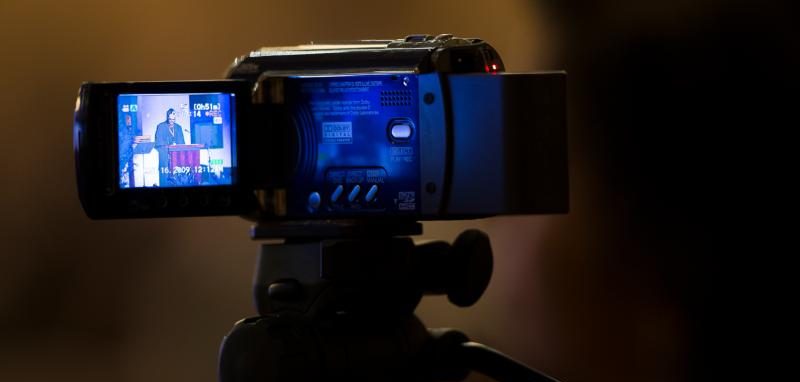
A camera records a guest speaker during the Fifth National Encuentro in Grapevine, Texas, Sept. 21. (CNS photo/Tyler Orsburn)
WASHINGTON (CNS) — For those who have lamented the cursory, superficial and too-often incorrect reporting of religion on television and radio, help is on the way.
The National Association of Broadcasters has issued a “Reporting on Religion Toolkit” to aid local broadcast stations in how to get the story right.
It is the second in an ongoing NAB “Awareness in Reporting” series that has been in the works for nearly three years, according to Marcellus Alexander, president of the NAB Education Foundation. The first toolkit, on race issues, made its debut a year ago.
[hotblock]
The religion toolkit was formally unveiled during an Oct. 22 symposium for journalists at NAB headquarters in Washington.
What does the toolkit have to say about the Catholic Church?
“There are nearly 1.3 billion Roman Catholics worldwide, more than all other Christian denominations combined. More than 70 million Americans identify as Catholic, about 20 percent of the nation’s population. It is the largest religious denomination in the U.S.,” it says.
“The U.S. Conference of Catholic Bishops is the assembly of the Catholic hierarchy of the United States and the U.S. Virgin Islands. Its members include all active and retired members of the Catholic hierarchy,” it adds, with a link to the USCCB website.
The National Council of Churches of Christ, an umbrella group for 38 Christian denominations, is the only other Christian group other than the USCCB to get its own paragraph in the toolkit. At the end of the “Christianity” page are links to 44 Christian denominations’ websites.
The homepage of the religion-reporting toolkit lists different faith systems alphabetically on the left column, starting with Buddhism, followed by Christianity, Hinduism, Islam, Jainism, Judaism, Native American faiths and Sikhism, with other links to atheism, secular humanism, cults, plus additional resources. Clicking on any of the religious groups’ links under “additional resources” takes the user to ReligionLink, part of the Religion News Foundation housed at the journalism school at the University of Missouri-Columbia.
[tower]
The toolkit was vetted by the consultants used by NAB who designed it, according to Alexander.
“Absolutely, absolutely. Religion is not the wheelhouse of the NAB. And our online toolkit would be as good as the input that we got from representatives of the different faiths,” he said.
“We will communicate via email to stations throughout the country as well as journalism school professors” about the toolkit’s existence and features, Alexander told Catholic News Service in an Oct. 19 phone interview. “The Broadcast Education Association is one of the partners in this initiative.”
The toolkit is “more designed to be centerpiece for a conversation around religion before there is a problem,” Alexander said. “Religion is one of those topics that has a lot of nuance, a lot of difference between religions, and stations don’t have a lot of resources to find out. That’s when we decided to do this.”
“When pursuing religion stories, reporters should consider social versus theological issues. How do the nonreligious issues that are the focus of the reporting reflect on a faith community’s religious identity?” asks the toolkit in its overview.
“Sacred texts are the written records of faith communities and they explain beliefs. However, interpretations may vary greatly, even within specific denominations and subgroups. Interpretation of these sacred texts and scriptures should be left to trusted, qualified theologians,” it adds. “Reporters who are not themselves theologians are likely not qualified to interpret these texts.”
“Understanding the structure of a faith community can help facilitate better coverage. Almost every faith community has denominations. There is unlikely to be a representative spokesperson for an entire community,” the toolkit says.
“An issue or topic can have multiple meanings and interpretations, even within faith communities and denominations, and depending on location. Paying attention to how members of a community characterize their beliefs and practices will provide cues for how to cover a topic.”
The toolkit can be found here.
PREVIOUS: God’s love ‘real, profound’ and can change your life, speaker tells youth
NEXT: Nuns on the Bus 21-state tour stirs support for ‘responsible programs’



Share this story